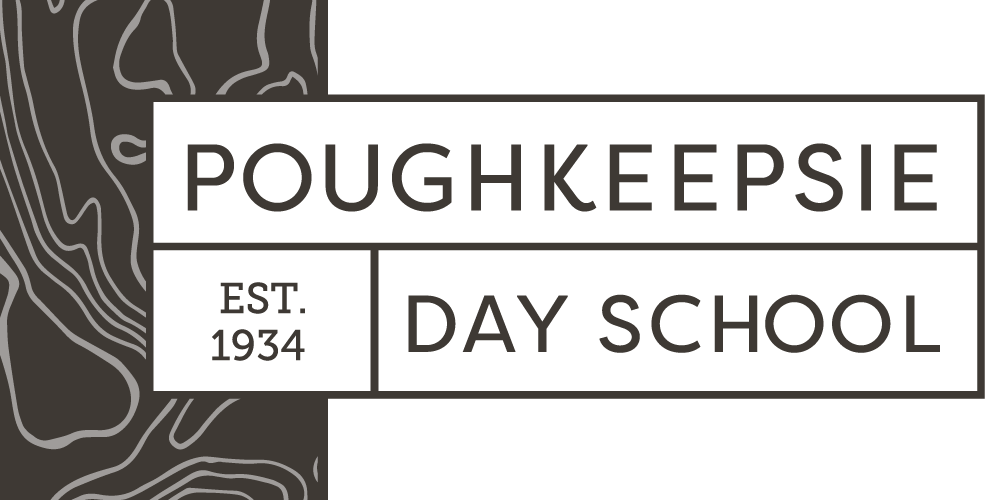PDS 7th and 8th graders engage in a mock trial of Lord of the Flies and arrive at a verdict.
By guest blogger, Andrea Tufts, Advancement Communications Coordinator
The 7th and 8th grade English classes enter the courtroom after being “scanned” by security Head of School Josie Holford. Here they will play out the drama of William Golding’s Lord of the Flies during a mock trial in which charismatic and controlling Jack is tried for the murders of Piggy and Simon. The trial is the culmination of active reading, annotating, making inferences, and lively classroom discussion. Each student, playing a witness, defense or prosecution attorney, has prepared a written persuasive argument for his or her position and must speak publicly. The jury is made up of the 8th grade class, who studied the novel and put on their own trial, last year.
“You are now in a courtroom and you must behave accordingly, or our Bailiff Molly will remove you,” announces Judge Rinaldi. She then proceeds to explain the protocols involved in a court of law – when to use objections, the role of the jurors and witnesses, and closing statements. “Jurors, your job is to find Jack either guilty or not guilty of killing Piggy and Simon, two separate murders.”
Witnesses Take the Stand
The trial begins as Piggy is sworn in, laying his hand on a spare copy of Lord of the Flies. “I swear to tell the whole truth and nothing but the truth, so help me Golding,” he repeats after the bailiff. Piggy gives his opening statement, citing evidence from the book to support his arguments. “Jack is not directly responsible for killing Simon. Everyone in the hunting circle is responsible for killing Simon. It would be unfair to prosecute Jack. “ And then speaking to the second charge, “I believe Roger is responsible for my death.”

Then bright-eyed Simon takes the stand. “I believe Jack is responsible for my death on the island. I believe Jack is also the killer of Piggy,” he says. During his argument, he cites evidence from the book to persuade the jury. The jury listens attentively while fervently taking notes.
Judge Rinaldi calls other witnesses: Roger, who enjoys being cruel, civilized Ralph and the Little ’uns. Each character has prepared a written statement with carefully cited evidence from the book to support their arguments.
“Roger leaned all of his weight on the lever. He did not call out to warn Piggy when the boulder fell. Roger is fully responsible for the actions leading up to the death of Piggy. He had a thirst for blood,” says Ralph.

Roger defends himself by saying, “I am in strong belief that Jack is responsible. He went completely crazy and I was under the influence of Jack. I am not loyal to him. The only way I would follow him was out of fear.”
The Little’uns point out that “everyone helped to kill Simon. It was the chant.”
The trial intensifies when Jack, the defendant, takes the stand. “I would like to plead not guilty for the murders of Piggy and Simon. I had no reason to kill Piggy and Simon was my friend. I have no motive. I had the boys perform the hunting dance because they were afraid of the storm. I was part of the hunting circle for killing the beast. I should not be charged for killing Piggy or Simon.”
The Defense and Prosecution Speak
The prosecution argues that Jack is guilty of both murders. “His behavior worsened on the island. He disliked Piggy and Simon. He had a hatred in his eyes. He should not be able to come back to England.”
The defense tells the jury that this is not a case for delusion or insanity; it is a case for murder. “Jack’s hunting obsession is a theme throughout the book. Since the boys in the hunting circle thought the creature that came out of the woods was a beast and not a boy they add, “But killing a pig is not the same as killing a human. Although it is violent, it is meant to provide food. Jack is not guilty for reason of insanity due to lack of adults, food, and good health. We recommend psychological testing.”
The Jury Deliberates
After deliberating about where to deliberate, the jury jumps into discourse as they analyze the facts of the case. “Raise your hand if you think Jack is guilty. Raise your hand if you think everyone in the hunting circle is guilty. Then Jack is guilty because he was part of the circle.”

“He wasn’t killing Simon on purpose. He thought it was the beast.”
“There is no real evidence that the circle was formed before Simon came out of the woods.”
“Jack was the one that got them to start dancing.”
“But they weren’t dancing to kill someone.”
Teachers Shirley Rinaldi and Jake Lahey observe the students from the background, allowing them to take ownership of the process. “It is good you are getting a bit loud. It means you care about the case and the process,” says Jake.
“It’s great to see how mature you can be when discussing thing,” notes Shirley.
The Verdict
The 7th graders are called back from an outdoor recess. Two foremen approach the front. The judge asks Jack to rise. “Jack is not guilty of murdering Simon,” states one foreman. “And not guilty for murdering Piggy,” states the other. Jack does a victory dance.
The verdict on learning at PDS: It requires students to synthesize information creatively, awakens the imagination, and is collaborative in nature.
Note: This blog post introduces the newest member of the PDS community, Andrea Tufts. Andrea works in the Office of Advancement, with particular responsibilities in the area of communications. Welcome to Andrea! The annual Lord of the Flies trial was an excellent introduction for you, to our education practice!



